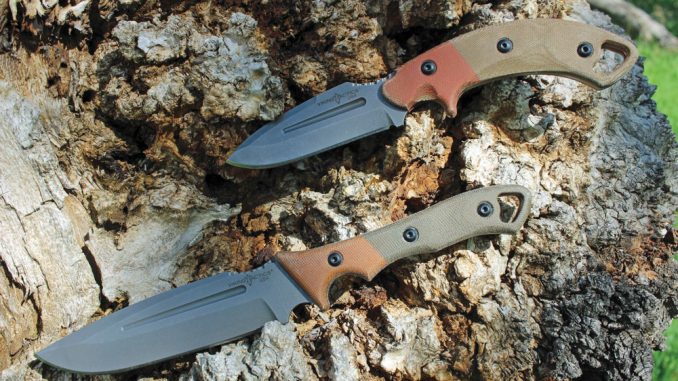
At SHOT Show 2020, not long before the world as we knew it was coming to an end, I was meandering through the booths and had something stop me dead in my tracks. I’d randomly wandered by the TOPS Knives exhibit and laid eyes on its latest knife, a collaboration with Kyle Lamb.
There, on the counter, was a line of blades the famed knifemaker created with Viking Tactics (aka VTAC), Lamb’s company. The three distinctive knives were called the Patriot, Crusader and Norseman. They grabbed my attention, and I had to stop to check them out. Because TOPS and VTAC are both synonymous with “high quality” in my lexicon, it’s not surprising that those knives were amazing.

The The Crusader, left, and Norseman are two of the three new knives created by a collaboration between TOPS Knives and Kyle Lamb, founder of Viking Tactics.
Kyle Lamb and Viking Tactics
Kyle Lamb has more than 21 years of service with the U.S. Army, more than 15 of which were with Special Operations (Delta Force). He saw service in such notable places as Mogadishu, Somalia and Iraq. Sergeant Major Lamb eventually retired and ported his lifetime of tactical knowledge into multiple business ventures that flowed from his particular set of skills, which include shooting instruction, creating tactical goods and authoring books, to name a few.
His company, Viking Tactics, has created a lot of great products, and it’s co-branded with other top companies—experts in their various fields—making sure that tradition carries on. Over the last few years, I’ve seen the Viking Tactics brand on a few items marketed to folks with a tactical bent, and they’ve all been top-notch; this tells me that Lamb has high standards. It’s no surprise that the collaboration with TOPS Knives falls within those same high standards.

The TOPS VTAC Norseman (bottom) and Crusader are two of three knives in a collaboration between these two well-respected entities.
Unboxing
I was happy to learn I’d be trying two of those blades for American Survival Guide. Receiving the knives during the pandemic, I was all too happy to take a respite from sheltering in place and get outdoors to do some testing.
However, the two knives didn’t yell “Bushcraft!” at me when they came out of the box. I did get the idea they could hold their own in that category and a few others, but these knives were designed for combat or defense (insert your mindset here). There were a few elements that led me to this conclusion, and the more I handled them, the more I was convinced.

Installing these sheaths is so easy. Start by unhooking the stems.
I first unboxed the Norseman and noted how well-balanced the knife was when I found the center of gravity in the bolster, which was roughly the middle. The Norseman, sitting on my workbench, whispered “seax” to me as I eyed it. Some things were different from those storied Viking fighting knives, such as its drop-point tip. I was impressed with the length, but the thing that surprised me was how thin the grip was.
The full-length tang was wrapped with Micarta scales done in a tasteful green and orange. Matching orange liners were sandwiched between the steel and Micarta. Starting at the back of the blade near the bolster, there’s a divot for the thumb that’s decorated in a “Viking vine” that runs the entire spine of the blade to the hilt. It’s a beautiful combination. Oh, and the blade was arm-shaving sharp.

Route them through the MOLLE however you prefer
Opening up the Crusader, I got another distinct impression that this knife leaned toward the combative arts. The curved handle fell right in with my previous training and use of a blade on a war or duty belt. Unlike the long, tall Norseman, the Crusader’s curved handle and shorter blade would be unobtrusive mounted on the waist. I could see myself easily accessing and using it with either hand.
The color scheme featured on the Norseman was also applied to the curved Micarta handles. The grip was nice—sort of like a rough pair of blue jeans. Here, too, I found the Viking vine done along the bent spine of the full-tang blade. The tip of the Crusader is a drop point, although it’s shaped very much like a spear point, with a thickening toward the spine. The Crusader was not quite as sharp as the Norseman but, right out of the box, it was still able to pull up hair.
Another noteworthy observation was the Kydex sheathes that accompany both of the knives. I initially overlooked these items in my excitement to see the blades, but they bring absolute value to the entire package. Tan in color, with riveted holes around the edges, the sheaths lock both knives in place with friction at the hilt. The MOLLE interface on the back was even more impressive. I’ve long lamented knifemakers who create marvelous knives, only to skimp on the clip or sheath. I’ve lost knives as a result, and this was a painful and sometimes expensive lesson.

Finally, close the stems to the sheath and make sure the spring-loaded retention bars click into place. This Norseman is now ready for action.
While initial impressions are often useful and sometimes stick, I was determined to take the knives out into the field and see how they performed on various cutting tasks. Every knife should have some diversity, although some knives are clearly designed with specific purposes.
I headed out into the mountains of northeast Colorado. Before all was said and done, I also ended up on a gun range for some testing that was somewhat more unorthodox.
The Norseman
Out in the mountains, I cut a couple of different types of wood—pine and cottonwood. The cottonwood was obviously denser, but it was no match for the 1095 steel. Both blades performed well, and I began to feel the distinct difference in the handles.
The Norseman appealed to a more general-purpose use because of its longer blade and thin handle; although for combat, it’s thin, yet strong, blade profile was keen. This knife is shaped in such a fashion that it can slash and pierce. I felt as if its smaller-diameter handle also allowed for a more diverse set of hand sizes to use it easily.

The Norseman is big enough to handle most bushcraft tasks, even batoning to split wood.
I noticed there were two finger choils—one in the handle and one in the 5.88-inch blade, near the handle. With these, I was able to choke up on the long Norseman, place my thumb in the divot along the spine and conduct some finer work with the tip. I cut several bushcraft notches into a branch and admired the ability of the large blade to work like a smaller one. I can only imagine that its ability to skin critters would be aided by this design as well.

The basic design of the Norseman reminded the author of an ancient Viking seax, but with upgraded features.
Eventually, with much wood work, I was able to get the Norseman dull enough to require service. Thankfully, the differentially treated 1095 steel shares the attributes of edge-holding while also being fairly easy to service. With a few trips over the sharpener, the big blade was push-cutting paper and ready to go again.
The TOPS Knives website gives some potent history behind the creation of this knife, stating that it was fashioned, “drawing inspiration from a knife made by one of SGM Lamb’s soldiers, who was killed in action in Iraq on 17 June 2005.” This is a fine homage.

The technology included in the Kydex sheath is impressive. The Blade-Tech MOLLE-Lok Short attachment points make navigating MOLLE panels a snap.
TOPS Knives Viking Tactics Norseman
- Overall length: 11.50 inches
- Blade length: 5.88 inches
- Blade thickness: 0.190 inch
- Steel: 1095, RC 56-58
- Handle: Micarta
- Weight: 10.1 ounces
- Sheath: Kydex with Blade-Tech MOLLE-Lok Short clips
MSRP: $225
The Crusader

The Crusader performed well during multiple cutting tests even though it is a fighter at heart.
With a blade that’s more than 3.5 inches long, the Crusader was no slouch. It easily cut all the wood I encountered, although its handle relegated it more to push cutting with my thumb along the spine. The grip also allowed for some finer controlled work. In addition, I tested the Crusader on some Virginia creeper I came across to create cordage. It did well in this capacity.
While gripping the Crusader, I noticed it differed from the Norseman in that it didn’t have two finger choils, per se; rather, it had a distinct sub-hilt built into the handle. This little dropped section of handle makes the overall design’s intention clearer: This is absolutely a thrusting weapon. The sub-hilt makes it easier to push in and—just as importantly—pull back out.
I eventually finished testing in the mountains but felt as if I’d missed out on the Crusader’s true calling.

On the war belt, I first tried the Crusader mounted in a vertical fashion.
I pulled out a 5.11 Tactical war belt and mounted the knife just to the left of the COBRA buckle on the front. Straight up and down, the knife was easily accessible to both my hands, providing a forward grip for my right hand and a reverse grip for my left. I headed to the gun range and was able to practice weapon-retention techniques that seemed to be the strong suit of the knife’s design.
Standing close to a target, I clamped my right hand over my handgun, trapping it while crouching low, and then pulled out the Crusader with my left, assailing my “attacker” (the target) before creating space, drawing my handgun and shooting. Multiple iterations of this served as drills, and the Crusader deftly handled the cardboard targets. I found that with grip adjustment, I didn’t even have to discard or sheathe the knife before shooting. The knife felt lightweight, but it was still substantial enough to not have to worry about what might happen when I stabbed targets and J-cut my way out.

Weapon-retention techniques are critical, and the Crusader serves this function extremely well.

With a modified grip, I was able to retain the Crusader and still deliver accurate fire.

Cardboard can wear down a knife. The Crusader handled multiple slashes and stabs throughout the entire day of training.
TOPS Knives Viking Tactics Crusader
- Overall length: 9.0 inches
- Blade length: 3.63 inches
- Blade thickness: 0.160 inch
- Steel: 1095, RC 56-58
- Handle: Micarta
- Weight: 7.2 ounces
- Sheath: Kydex with Blade-Tech MOLLE-Lok Short clips
MSRP: $210
Shared Features
Both the Norseman and Crusader share multiple features, and I can’t help but guess they also apply to the third knife in the TOPS Knives Viking Tactics line—the Patriot. (While I didn’t review it for this article, the Patriot is a tactical cleaver-style knife with a 3-inch curved blade.)
The Micarta scales on these knives offer great contact on the surface, striking a good balance between grip and not wearing on the hands. Additionally, the three hex nuts in each handle allow the user to service or tighten them.
All the knives in the series have a sizable lanyard hole in the end of the grip, adding to their usefulness.
“[The Norseman] is shaped in such a fashion that it can slash and pierce. I felt as if its smaller-diameter handle also allowed for a more diverse set of hand sizes to use it easily.”
The blades, themselves, are a gorgeous mottled gray that TOPS calls its Acid Rain finish. Only the very keen convex edges gleam a brilliant silver when catching the light. The Crusader and Norseman both have a fuller that runs about three-quarters down their blades.
The sheaths are extremely well-done and use one of the best MOLLE mounting systems I’ve seen in a while. The Blade-Tech MOLLE-Lok Short attachment points are a little offset, giving them some torsion within the webbing. Two stems swivel out from the sheaths so you can snake them through the webbing. The stems then swivel closer to the holster; and hooks in them catch spring-tensioned bars mounted on the sheaths. Everything locks up solidly, and the knives won’t fall out.
The Viking Way
The Norseman and Crusader are quality knives that pay tribute to a man who’s spent a good part of his life fighting for our freedoms. He continues to pass on the knowledge he earned to a wide group of people, even today. TOPS did an excellent job bringing this series to life.
“Because TOPS and VTAC are both synonymous with ‘high quality’ in my lexicon, it’s not surprising that those knives were amazing.”
Whether you’re “pillaging, hunting or conducting modern-day combat operations,” as the TOPS website states, the form, finish and materials guarantee you’re getting a quality product that can be maintained for a lifetime of service.
SOURCES
TOPS Knives- (208) 524-0113; TOPSKnives.com
Viking Tactics- VikingTactics.com
Editor’s note: A version of this article first appeared in the October, 2020 print issue of American Survival Guide.





Be the first to comment